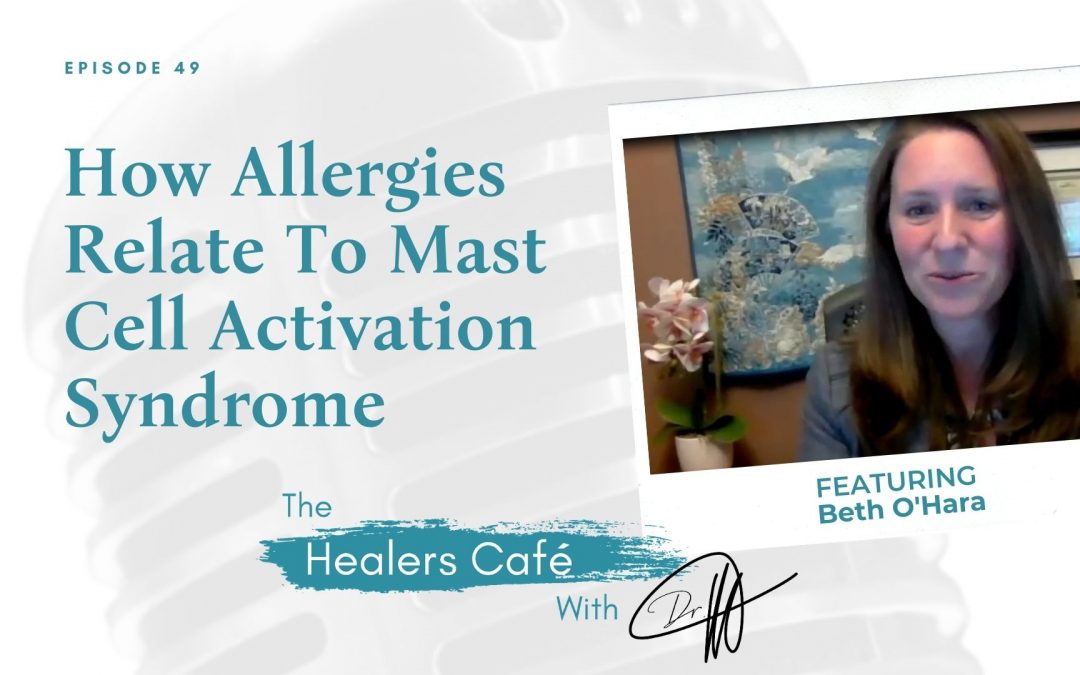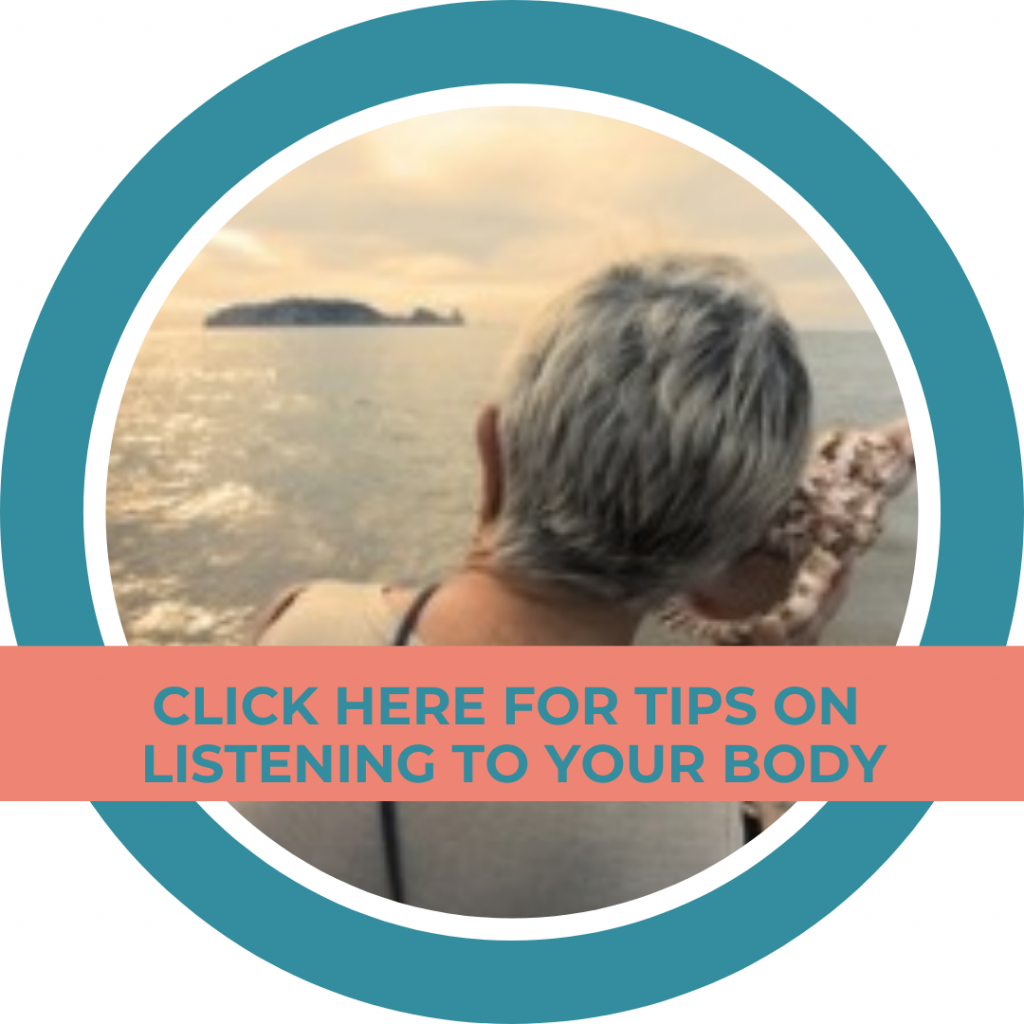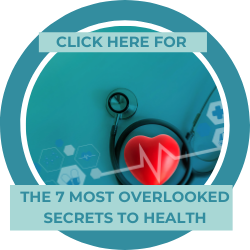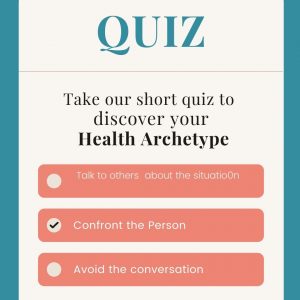How Allergies Relate To Mast Cell Activation Syndrome with Beth O’Hara on The Healers Café with Dr. Manon Bolliger, ND
In this episode of The Healers Café, Dr. Manon Bolliger, ND, chats with Beth O’Hara Functional Naturopath, specializing in complex chronic immune conditions related to Mast Cell Activation Syndrome and Histamine Intolerance
Highlights from today’s episode include:
Beth O’Hara 02:57
The reason that people want to stick around and listen to this, is that mast activation syndrome is one of the most under-recognized conditions, and one of the most common, which is so interesting about it. Because studies have shown us that between 9 and 17% of the general population have mast activation syndrome. So we just take a second to think about that. We’re talking like at least 1 in 10 people, that’s quite a lot. And that’s just a general population.
Beth O’Hara 07:10
Our mast cells are in every system in the body, almost every tissue. So we have to know that to think about the symptoms, and that the mast cells are here to be our frontline defending immune cells. So they’re sensing toxins and pathogens, they’re also sensing stress.
Beth O’Hara 09:28
So you take your front line defenders of your immune system, you knock out their response, and they coordinate the whole immune response to you just kind of knock that whole part out. And then the Lyme, Bartonella, babesia, Epstein Barr the mold, colonize in the body and had free rein. So that’s the approach that is different is learning, not think about the mast cells or what’s wrong and knock that out, we need to think about what’s triggering underneath that’s making the mast cells over-reactive.
About Beth O’Hara
Beth O’Hara is a Functional Naturopath, specializing in complex chronic immune conditions related to Mast Cell Activation Syndrome and Histamine Intolerance. She is the founder and owner of Mast Cell 360, a Functional Naturopathy Practice designed to look at all factors surrounding health conditions – genetic, epigenetic, biochemical, physiological, environmental, and emotional.
Her subspecialties are Mold Toxicity and Genetic Analysis in the area of Mast Cell Activation and Histamine Intolerance.
She designed Mast Cell 360 to be the kind of practice she wished had existed when she was severely ill with Mast Cell Activation Syndrome, Histamine Intolerance, Neural Inflammation, Lyme, Mold Toxicity, Fibromyalgia, and Chronic Fatigue. Her mission today is to be a guiding light for others with Mast Cell Activation Syndrome, Histamine Intolerance and these related conditions in their healing journeys.
Through her Mast Cell 360 Root Cause process, she discovers the unique root factors affecting each of her clients’ health issues, building personalized, effective roadmaps for healing. She holds a doctorate in Functional Naturopathy, a Masters degree in Marriage and Family Therapy and a Bachelor’s degree in Physiological Psychology. She is certified in Functional Genomic Analysis and is a Research Adviser for the Nutrigenetic Research Institute. She presents at Functional Medicine Conferences on Mast Cell Activation Syndrome and Histamine Intolerance as well as the use of genetics and biochemistry in addressing chronic health conditions.
About Dr. Manon Bolliger, ND:
Dr. Manon is a Naturopathic Doctor, the Founder of Bowen College, an International Speaker, she did a TEDx talk “Your Body is Smarter Than You Think. Why Aren’t You Listening?” in Jan 2021, and is the author of Amazon best-selling books “What Patient’s Don’t Say if Doctors Don’t Ask”. & “A Healer in Every Household”
For more great information to go to her weekly blog: http://bowencollege.com/blog.
For tips on health & healing go to: https://www.drmanonbolliger.com/tips
SOCIAL MEDIA:
Dr. Manon, ND – Facebook | Instagram | LinkedIn | YouTube | Twitter
About The Healers Café:
Dr. Manon’s show is the #1 show for medical practitioners and holistic healers to have heart to heart conversations about their day to day lives.
Follow us on social media! https://www.facebook.com/thehealerscafe
TRANSCRIPT
Introduction 00:10
Welcome to The Healer’s Cafe. Conversations of health and healing with Dr. Manon.
Dr. Manon 00:25
So welcome to the Healer’s Cafe. Today I have with me Beth O’Hara, and I’m really excited to do this interview because she’s a Functional Naturopath specializing in complex chronic immune conditions related to mast cell activation syndrome, and histamine intolerance. She’s the founder and owner of MastCell 360, a functional natural therapy practice designed to look at all factors surrounding health conditions, genetic, epigenetic, biochemical, physiological, environmental, and emotional. Her specialties are mold toxicity and genetic analysis in the area of mast cell activation and histamine intolerance. I really feel so privileged to have you on this show, because I feel like it’s an area that both conventional medicine and naturopathic medicine don’t really dig into. We have some ideas for all this and we see there are problems, but I would love for you to explore that. But first of all, welcome. How did you get into this? This is such a specific field of study, why don’t you share it with us?
Beth O’Hara 01:57
Well, first, thank you for having me on. I’m excited to be here with you as well. And I find that this conversation is often a game-changer for people. The reason that people want to stick around and listen to this, is that mast activation syndrome is one of the most under-recognized conditions, and one of the most common, which is so interesting about it. Because studies have shown us that between 9 and 17% of the general population have mast activation syndrome. So we just take a second to think about that. We’re talking like at least 1 in 10 people, that’s quite a lot. And that’s just a general population. As I talk with my colleagues in this area, we’re finding that observationally, over 50% of people with chronic illness are dealing with it because of how these mast cells connect to all the systems in the body. They’re in all the systems of the body. But of course, I got into this because that was my journey. As a child, when I was young, we moved out from this little small city area out to the country in Western Kentucky, and we moved to this old farmhouse. And it was kind of this fixing up this old farmhouse and nobody knew anything about toxic mold. And my health just kept going downhill, the longer we lived there, and my family members had some health issues, too. My dad had a heart attack at 36, and so it wasn’t just me, but I was having trouble functioning. There were some other things, I had been kicked by a horse at the top of my head, and so that caused some brain injury. But my dream had been to go to medical school, and I was pretty gung ho on that and so I was very dedicated. And by the time I got to college, I could hardly get out of bed. And I just had this debilitating fatigue, severe fibromyalgia pain. I had a full …
Read more...
scholarship to medical school, just hard to get, I had to turn it down. That was utterly devastating. So instead of going to medical school, I became a chronically ill patient, on this journey, figuring out what is going on, why is my body falling apart? Why can’t I function? Why do I have severe anxiety? Why can’t I sleep and I couldn’t drop into sleep as I could just drift.
Dr. Manon 04:41
So before we go deeper into your story, just to get a sense of if anyone listening here is having symptoms, what are the kinds of symptoms? I mean, I’m sure it’s like, ‘Oh, we don’t know what’s wrong with you, but something’s wrong’. Like those probably all fit, but what are the typical states and symptoms that people experience when they have this?
Beth O’Hara 05:10
That’s what’s so hard about it, and part of the reason that one a lot of people hesitate to work in this area. And also, mast activation syndrome was considered theoretical until 2016. In 2016 was when we got the official diagnostic code was in place. And it’s still not taught in medical programs as far as I’m aware. I don’t know how much is taught in naturopathic programs, but probably more. And it’s just not being taught yet, and if people haven’t been in it and immersed in it, it’s hard for them to know about it. Our mast cells are in every system in the body, almost every tissue. So we have to know that to think about the symptoms, and that the mast cells are here to be our frontline defending immune cells. So they’re sensing toxins and pathogens, they’re also sensing stress. And so they are positioned at every nerve ending through mast cells in the brain and the limbic system and then our whole respiratory system, entire GI tract, the skin is full of mast cells, muscles, bones, reproductive organs, all the abdominal organs. And the mast cells can release over 1000 different mediators. This is why it’s hard for people to pin down because you can get tons of different types of symptoms. The classic symptoms that people look for are flushing, I’ve never worn blush because my cheeks are always kind of rough. But people can have a pale complexion as well. The allergy symptoms, runny nose, itchy, watery eyes, itchy throat, sneezing, postnasal drip, rashes, those kinds of things, flushing after eating high histamine foods. Those are some common symptoms, and what’s thought of as the classic presentation. And people have to have symptoms in two or more systems. So say we’ve got skin’s involvement. Like we’ve got rashes and flushing. And then we’ll have something else like gi symptoms or nervous system with issues with sleep and anxiety, or might be chest tightness and coughing, things like that. I see a lot of people being missed and the diagnostic criteria are missing 90% of people’s mast activation syndrome right now. It needs some work. It’s still in flux and evolution. But part of the other problem is people think that, okay, we’ve got these diagnostic criteria that are solid, that’s what should catch everybody. And it’s not particularly an allergy and immunology, I’m finding people are being missed because there are these expectations, classic symptoms. But I have clients, I’ll call her Jane, she doesn’t actually have any skin symptoms. She has acid reflux, she has alternating diarrhea and constipation, trouble falling asleep, she has anxiety, and then she gets this chest tightness that happens sometimes after eating. So that’s a whole nother presentation. And then sometimes people show up, and they’ll have insomnia, they’ll have neurological pain, they’ll have reproductive issues like they’ll have very heavy periods, painful periods. And that might be their presentation. So everybody presents differently and out of hundreds and hundreds of people, I don’t have two people that look the same.
Dr. Manon 09:05
So typically, then the diagnostic procedures I can imagine medically you’re checking also to see if there are any sensitivities and allergies. That would be part of it. But it doesn’t really give you the full solution.
Beth O’Hara 09:28
Correct, yes, because we have to think about…so the traditional medical approach is if there’s mast activation syndrome, let’s do these h1 and h2, antihistamine blockers, we’ll find the combo that calms your symptoms. And the problem with that is it knocks down this mast cell response. The muscles are creating inflammation in response to what’s happening. They should be right, but we live in this toxic world. So we’re constantly bombarded with toxins. We live in a very stressful culture. And especially if you watch the news at all. So we’re constantly bombarded with stress if you drive in traffic if you balance your checkbook, all this stuff, and we have higher, we have EMF levels as we’ve never had, in the whole history of humanity. We have mold levels as we’ve never had in the history of humanity. So it’s like these mast cells never get a break. And if we do this h1, h2 blocker approach, that can be very helpful if people have a lot of symptoms when you calm it down, and we need to break a cascading flare cycle, right. But if that’s all we do, and that’s what was done with me, as a child, we didn’t even know that word mast activation syndrome, so then that phrase did not exist. But it helped and it made me more functional for a while, and then I got so much worse. And because what was underlying my mast activation syndrome was not detected, and it wasn’t addressed. So the mold toxicity, I had Lyme, Bartonella, babesia, Epstein Barr all this stuff. So you take your front line defenders of your immune system, you knock out their response, and they coordinate the whole immune response to you just kind of knock that whole part out. And then the Lyme, Bartonella, babesia, Epstein Barr the mold, colonize in the body and had free rein. So that’s the approach that is different is learning, not think about the mast cells or what’s wrong and knock that out, we need to think about what’s triggering underneath that’s making the mast cells over-reactive.
Dr. Manon 11:47
So the typical approach, it’s like getting rid of the messenger, rather than listening to what’s going on. But so, from a naturopathic perspective, though, we have been trained not to do that. But we would then be removing the so-called offending elements. And that can I mean, sometimes it works, if you can identify it’s avocados or whatever. Or if it’s dust, you’re a little bit more challenged, because it’s very hard to constantly stay on top of that. But when you can’t remove the one thing, which is so many people that I’ve seen, it’s like, it may help for a while, but you have to even go deeper. So can you speak to that a little bit about what your experience has been with that approach, which is eliminating the things that cause the initial reaction?
Beth O’Hara 12:48
That’s a great question. I have a lot of people come into my practice. And I was just having a conversation with somebody last night, who’s actually a physician, and she is very concerned about this food triggered by mast cells, this supplement triggered by mast cells. And at some point, we want to track that and I have everybody do a low histamine, low lectin diet, a trial for six weeks, see how that goes. It’s within reason, you know, if they’re down to five foods, obviously, we’re not going to do that. But if we’ve got variety, then we try that. But at some point, we can’t keep whittling down. And it’s not even so much about, well, these foods trigger me so I avoid these foods. It’s again, why are those foods triggering the mast cells? Why is that bucket so high, and I find that 95% of people in my practice, I keep upping this number as I go. So it used to be 80%, and then it was 90. Now I can solidly say 95% of people in my practice are dealing with Nervous System dysregulation and mold toxicity. So healing the layers back, no matter what else is going on. If they’ve got chronic Lyme, chronic activated, Epstein Barr, all of these other things, those have become the two major starting points. Because mold toxins will dysregulate everything. It’s like you just get this stacking up of hormone dysregulation, nervous system dysregulation, gut dysregulation, on and on and on. And the mold toxins are going to affect that th1 th2 balance so they tip you into this low pathogen killing response, high chronic immune inflammation, and then you can’t keep these pathogens at bay like Lyme and Epstein Barr. There’s actually a lot of people who have done 2-3-4 years of Lyme treatment and they’re still sick. And the mold layer wasn’t addressed. So when we pull, I like to do this slide when I’m presenting at conferences where we have, like that Jenga game with the wooden blocks. But in this slide, we’ve got a single block on the bottom, and then all these other blocks. And our goal is to knock the tower down. And we’ve got blocks for Lyme and CBOE and Epstein Barr and insomnia, and hormone dysregulation, thyroid issues, the very bottom block is mold. And so if we keep working upstream up here, we can get so far, but it’s just a moving target and just kind of comes back into just chasing it. When there’s mold there, mold toxicity is so common now, if we pull that block out, that is like the culprit instigating all these dysregulations, including the mast cell dysregulation many times, then the tower can fall down. We can see what’s left standing. And then those things either come back on their own, or it’s so much easier to balance them at that point.
Dr. Manon 16:05
I love your approach. I mean, it makes absolute sense. And that’s the problem with this idea of diagnostics. Now we’ve diagnosed a piece, a part, a system reaction rather than the cause. And I think that all kinds of medicines, whether it’s naturopathic or allopathic fall into that diagnostic category, right? We’re saying, okay, that’s the problem, right? But I love that you’re going, what’s the cause? The cause of the cause? And I want you to address the nervous system. I mean, in my practice, that has been a huge part. that once we reregulate, and I actually use the word reboot, reboot your body. But, once you have the nervous system working properly, and also working through the fascia, which is also more recent, as far as information, it changes all of our internal systems. And so I look at that as such a basis to it. And yet, I have seen people that seem to be enough to make them seemingly completely healthy. But there are people where I would agree there’s still something going on. And what you’re saying is that it’s basically fungus, that’s the big deeper toxicity, right?
Beth O’Hara 17:43
If it’s there, yeah. If it’s there, it has to be addressed first. Now, there are always exceptions. If somebody has a cute Lyme, then that should be addressed. And I do have to give credit where credit’s due. And a lot of this comes from Neil Nathan’s work, and I didn’t come up with it on my own, but we’ve worked together on research around how mold toxins are detoxed in the human body. And we even have that mapped out now that these toxins are better than do these binders. And these mold toxins, most of them don’t use glutino for detox. They use glucuronidation. So that’s a game-changer, that piece in terms of the detox but rewinding that, with mast activation syndrome, whether somebody has mold toxicity or not, we have to address the nervous system. And I found I did not take that seriously enough. Until I hit my own walls, and I was doing everything on the supplement side, and the detox side. And because the mast cells in the nervous system are in constant communication, I find this fascinating, I did a course on this called the Mast Cell Nervous System Reboot for laypeople to step themselves through. We’ve had a lot of practitioners take it too, but the nerve endings, here we’ve got mast cells and the nerves release these neuropeptides and neurotransmitters, and the receptors on the outside of mast cells picking that out. And then the mast cells are releasing all of their mediators that communicate and affect the nervous system. And that’s happening in the limbic as well. And I’ve done experiments on one of my first symptoms…
Commercial Break 19:37
Hi, it’s Dr. Manon and I just want you to take a moment, commercial break to ask you to subscribe to my podcast and kindly leave a comment if you’re enjoying this. And also just to let you know I have tips for people in health looking for solutions to some variety of issues. It’s more like an attitude of health. And they’re entertaining short videos. And you can find these under drmanonbolliger.com/tips other links are here, and I look forward to hearing from you.
Beth O’Hara 20:21
…flaring is swelling in my knuckles. And so I’ve done experiments where I’ve cycled on something in my brain, and spiraled down into it. And within about a minute or two, my knuckles will swell, sometimes 30 seconds. And then I can shift myself overusing the tools that I know, into this calm. I call my limbic system, I call my Vagus nerve, I work on that, and that swelling will be gone Manon within two to five minutes. That’s the power of it. I’ve used it to shut down an asthma attack I thought I was going to go to the ER for. I always tell people if you need to go to the ER go, but there have been times where I’ve had major mast cell flares, and use that plus the mast cell supporting supplements to be able to get it under control again.
Dr. Manon 21:19
Well, I mean, we’re actually unbelievably well built if we understood the different systems of activation and how it’s all so integrated. So something as simple as a breath can actually shift things. And often we don’t go too simple things, we think we need something big outside, you know, mega wars center to change things. And it’s not the truth. We’re really set, we can heal simply as long as we honor the body, and we work with it.
Beth O’Hara 22:05
We have to work on it, I find the missing pieces are, we have to work on the limbic system and the vagal nerve to get things right, in very specific ways. I had this whole background as a yoga therapist, all these things, so I’ve done a lot. But I hadn’t done these very specific tools when we think about the nervous system, and the mast cells are there to defend against danger, detect danger, and defend. And so if we’re driving in traffic, our limbic system and our mast cells have no idea, are we driving in traffic? Are we facing a bear? You know, there’s no way to distinguish it on that level. And we live in this world of a constant bombardment of stress. And so we’ve got to have these times in the day where we just reset it or reboot it. That’s if people only do that piece, they’re going to get, whether they’re doing mast activation syndrome or any other kind of chronic illness, or they’re going to get much further down the road faster.
Dr. Manon 23:12
So with the mold itself, how do you go about testing that when you suspect it? Which it can be suspected many times, but if people have tried working with their limbic system, their nervous system, they’ve done many different things to help it, not just mask it. I mean, it’s easy to start suspecting that there’s something wrong, and what are your steps? And what do you do to get people to check if it’s true and how?
Beth O’Hara 23:52
Yeah, well if I can take you through the whole piece, we do the nervous system calming and we start mast cell calming supports while we’re getting those test results back. And one, people have to test their homes and research is showing us that over 50% of all buildings in the United States are toxic. And we’re talking mold toxins, we’re talking VOC’s, and mold has become a huge issue because of our electromagnetic fields are actually causing the mold to grow many times faster. Some unpublished studies are estimating 400 to 600 times faster. That’s a lot and we don’t know what that means in our bodies.
Dr. Manon 24:39
No. So can you explain how that happens? Like to somebody who’s like, oh, what is that? And, there’s a lot of skeptical people, so how do you explain that?
Beth O’Hara 24:51
First of all, if anybody’s ever had the experience of trying to clean mold, and then you start to feel sick. Anytime mold is threatened with a cleaner, anything, if you try to scrub it, it’s going to immediately start producing more spores and more mold, toxins, mycotoxins, that’s its defense mechanism. EMF’s have not been on the planet, like what we get from moving magnetic fields and things like that. But what’s coming off of a Wi-Fi router or laptop or cell phone, this is new. And mold doesn’t register that. Same with our mast cells, they don’t know how to respond. So both organisms see it as a threat. Molds see it as a threat by increasing its growth, it’s trying to survive, and doesn’t know that it is just a danger in the system. So that’s one of the pieces, there are other pieces of why we build buildings much tighter. So we trap the moisture in and our humidity levels are higher than they’ve been. So we got to test the home. It’s very hard to find a really good mold inspector because air testing is not enough, we need to do mold spore testing, we need to do multiple ways of looking at it. And then for the body, we do urine testing, which is my preferred way. And there are three major labs that are doing it. The two that I find the most helpful right now are Real-Time and Great Plains, and generally, I start with the Real-Time. And then if we have the budget for it, we can get both, that’s great, we can get Real-Time and Great Plains. And they have to be gently provoked if possible. So we do little Blueithion before the Real-Time as somebody tolerates it. But there’s never a need to go into flaring or feeling sick and sweating before both of them. And I’ve got some details that people are looking for some real details, we’ve got some on our blog, there’s a whole mold section on the blog. And those two tests, almost always I’ll get something back. But occasionally, people are so sick that their body is keeping it tucked in the tissues. Mold toxins are not freely circulating unless there’s a lot of them or your detoxing. They’re going to be stuck in the fat tissue and the muscles and the organs, and we’re only going to see on the test what is coming out in the urine. So often those levels in the first test will be quite low, they may even be right below the cutoff, but will test positive. If that comes back negative and we still have a suspicion, there’s a test by Vibrant that is a little more sensitive for things like that, and beyond some of the other mold toxins. And there’s a company called My Michael Lab that will do antibody testing, some blood tests for mold toxins. And those are all valid methods. My protocols are based on the urine testing. So that’s what I work with most but occasionally I’ll do that antibody testing if we need confirmation and the person just can’t excrete those toxins.
Dr. Manon 28:14
That seems very comprehensive that you can get to some sort of answer. But if we go behind that now we’re in an environment that is definitely more toxic. So I agree with you there for sure. If we have symptoms, then it’s worth definitely looking at this. Have you found ways of working with your system so that you’re less likely to develop this? Like, young children? I mean, of course, they may be more prone. If the family is or if they’re brought up in a toxic environment, but have you found preventative ways?
Beth O’Hara 29:01
There are lots and those people don’t come to my practice. No one wants to put money into it when they’re healthy, right? They’re always, like mold, toxins, testing for that. I just had my husband test. He’s not having any major health issues, but I know the long term effects. So I talked him into it. He was in the military and he lived in base housing. Base housing is notorious for mold toxins. Schools are notorious because they close up for the summer, dorms, lots of lots of places you can get exposed. But if there is any mold toxin, getting that out is huge. Because those toxins are hormone disruptors and carcinogens. And they’re behind most of the neurological diseases or major root causes like Alzheimer’s, Parkinson’s. So that’s a huge preventative and when I have people who do say, ‘Well, I just want to see if we can optimize for my partner’, or something like that, that’s the first place I suggest. Doing something for Nervous System support, even if you’re healthy is huge and do it on a daily basis. It’s key for cancer prevention, and autoimmune prevention, and diabetes prevention. So there’s just some big ones and eating clean, making sure that water is clean. We just have so much more chronic illness, cancer, all of this, than the studies that look at all the extenuating factors show us that we definitely have an increase in the last 50 years as our world’s become more toxic. Just avoiding those toxins is management.
Manon Bolliger 30:47
And with foods, I think if I heard you, right, you mentioned avoiding lectins. Can you speak a little bit more about that?
Beth O’Hara 30:58
Sure. So lectins are, this was really popularized by Dr. Gundry and he has all stuff on lectins, and they’re a protein in certain plants or in most grains….wheat, corn, barley, rice. There are few no lectin or low lectin greens, but most of them have lectins. Nightshades are a big reason why Nightshades trigger autoimmunity and trigger inflammation in the joints and arthritis. So those Nightshade foods are gonna be like tomatoes, peppers, eggplants, and then anything in the new world category vegetable category. So we’re talking sunflowers, squashes, pumpkins, and the nightshades or new world. like what was growing in the Americas. Those are all high lectin foods and some fruits have lectins. Well, the reason how this ties in with mast cell activation, there is a receptor called the C type lectin receptor on the outside of the mast cells. It’s what they used to detect fungal species. Candida and molds and so on and respond to. But also the lectins in protein can dock there. So if you have a leaky gut, or just lectins can trigger gi symptoms with the mast cells that line the gut. And not everybody is sensitive to them. But if people have mold toxicity, it can help to take a break from that and see if there’s a difference. So I have this residual joint burning and had all this joint stuff. I’ve been on a cane by the time I was 28. My friends were out dancing, and I was hobbling to the bathroom. That was oxalates, I finally figured that out took 10 years. I still had this rigid residual burning, and when I stopped eating corn and the other lectins it was gone within two weeks, totally this burning I’ve had for over 10 years. And then if I start eating them again, it comes back. And that’s my experience and it helps some people, doesn’t help some. So that’s why we do it as a trial.
Manon Bolliger 33:16
My belief and I’ve pretty well been able to demonstrate this in most cases to be true, is that foods are not always…like to remove a whole category of foods, it’s like we need to go deeper than that. It’s like, there’s got to be something that triggers us to be so sensitized to these foods when you’re sick. I agree, you want to take down any load on the body, anything that causes more inflammation or more reactions. But do you really feel like people need to remove, for example, all lectins if they’re sensitive? I mean, once you’ve identified the problem, do you feel that people have to be on these restricted diets? What’s your experience?
Beth O’Hara 34:15
I don’t like people to be restricted long term, as long as we’re healthy. So I always talk about we don’t want to keep whittling down, we want to think about replacing, not removing. And I work with a lot of different food sensitivities to histamines, and oxalates, and salicylates, and fodmaps, and outside of your typical antibody testing. And the lectins or the one that…so we want to reintroduce foods as much as we can even histamines. I’ve gotten a lot of histamine foods back. I’ve gotten oxalate foods back, not all but a good number. The lectins, if they’re cardiovascular disorders, if there is cancer history, if there are GI issues, that’s the one category that people might want to really limit long term if they have those. Now, if there’s no history of those, they may be okay with them. But there is a good…Dr. Gundry made a really good case on the links there. He sold me on that piece. And that’s what motivated me to stop the corn. But I still have rice on occasion, or little sunflower seeds, or pumpkin seeds. So I’m not strictly avoiding. But I’m limiting and I’m watching my body. I think the more we can tune into our bodies, and I think that’s part of what you teach as well, on a very large scale is, how do we tune in? How do we notice? And how do we be in touch with the impacts? And the more we can do that? Also, the better we’re going to navigate because an outsider can only give you some guidance, and then you have to, as the person implementing, see what works for you and what doesn’t work for you.
Manon Bolliger 36:07
I think it’s hard to do like a cookbook, or this is how it is for everyone. We’re just so…we’re different. We’re similar, but we’re different. And we have our own paths and our own triggers. And there is that whole mental-emotional part that you talked about as stressors too. So you can’t say, ‘Well, this is your path only’, right? It’s really identifying and helping the client identify, and also pay attention to themselves, because so many people, they want an outside, quick-fix solution.
Beth O’Hara 36:45
I am not the right person for that.
Beth O’Hara 36:48
Exactly. I’m sure, by the time people find you they’re more than open to something else, because they’ve tried everything,
Beth O’Hara 36:59
Usually, the people with mast cell activation syndrome are the ones who keep falling through the cracks, you know, tried 5-10, I had counted out, I stopped counting at 50 practitioners, I had seen trying to get help, and then finally realized this is before way before 2016. And so I finally said ‘I’m going to have to figure this out’. So most well trained, functional medicine doctors in our area, this is also before telehealth, so I didn’t have access to the kind of people you do now. But he told me, he said, “That I don’t know what else to do with you, you react to everything we try. We keep doing all this stuff, nothing.” And I was diligent, I did everything I was asked to do. So I finally said, “I’ll have to do it, I’m going to have to figure this out”. And at least I had that pre-med background, and that’s what I did. I couldn’t hardly work, so I did and finally, I crawled out of the hole, I got my health back, my life back, and was able to go back to school and get this built but with this whole other windy road than I thought it was going down.
Manon Bolliger 38:09
It’s about lots of personal experience in that too. And, and I think it’s interesting how many times when I interview people, it’s their own health journey that leads them to finding the solution or being in the field where they’re working with something that resonated with them to make them better. But that’s why I’m so excited to speak with you because this is not a subject that people easily talk about or where I mean, there’s an awareness now, but it doesn’t mean there’s a solution or next steps. So I was going to ask you…you sent details, but you have, obviously a website or something that people can find out a little bit more and I’m sure that a lot of people are going to be asking ‘Where do I do my next step”. So do you know the link?
Beth O’Hara 39:07
Yeah, so if people want more info, go to mastcell360.com. And there’s an MCAS menu. And under there, it’ll say, what is MCAS and what is our symptom survey? Those are good starting points. Take this, read about emcass, what is it? Take this symptom survey and then if you score more than 50, that symptom survey was based on the research literature. Then I’d look into the Mast Cell Nervous System Reboot. We’ve got up there and the top eight mast cell supporting supplements, but we have tons of free resources on the blog. And we’ve got a great Facebook community, and it’s just facebook.com slash mast 360 degrees. Facebook Lives almost every Monday at two Eastern and people can ask questions. There’s another topic each week and we just have a good time coming together and so we try to have lots of options for people and resources.
Dr. Manon 40:14
That’s great. Okay, well, I’ll definitely put that link as well. And I want to thank you for being on the show.
Beth O’Hara 40:22
Thank you so much for having me and I love that we can team up like this and reach more people and help them get their health and lives together.
Thank you for joining us. For more information, go to DrManonBolliger.com.







